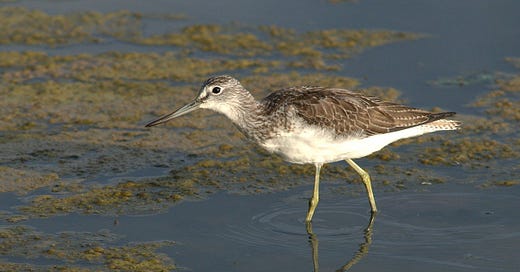How do you like to spend your time awake in the small hours?
For me it’s thinking about all the mistakes I’ve made in my life. Occasionally I prefer to mix things up and contemplate how everything I’m doing now might go wrong.
But restlessness in the dark can have its rewards. Late summer and early autumn is the best time for a chance auditory encounter with migrant waders, as they pass invisibly over our homes.
One of the loudest and most likely to be heard through an open window is the greenshank. Their sharp, piping cry typically consists of three notes.
The three notes at the beginning and end of this recording are the typical distinctive call, but those four- and five-note phrases are commonly heard too.
While similar to other wader-made noises, the greenshank’s notes have a notably piercing, pure quality.
Encountered by day, you may see the source of the noise, and note the greenshank’s long, slightly up-curved bill, long legs and overall pale, grey-headed appearance.
The whitish rump, extending in a V-shape up the back, helps distinguish them in flight.
But often as not it’s the sound that we encounter, rather than the visible bird. Greenshanks tend to call frequently during their migratory flights, and also when disturbed from the muddy estuarine creeks and large freshwater pools that they like to feed in.
A thousand or so pairs breed in Scotland, with larger populations in Scandinavia. Here, in high summer, they are birds of boggy, windswept places.
For those of us in the more southerly areas, the migration seasons are most likely to yield that wild sound, as the birds fly to and from their wintering grounds further south.
Greenshanks are generally uncommon birds in the UK, but they do have an expansive global distribution. In summer birds nest from Scotland all the way across the boreal zone to the east coast of Russia. In the winter they can be found across Africa, through India and South East Asia to Australia and New Zealand.
Isn’t it reassuring to know those triple notes are heard so widely across the world? One less thing to worry about, in the dark.
Read about how we know where Scottish greenshanks spend the winter on Graham Appleton’s Wader Tales blog.
This is the last shriek of 2021. You can find all 34 that have been published since January in the archive. I hope they have helped you identify a new bird or two by ear this year.
I’m always keen to hear what successes have been had (and what entertaining mishaps). Do share yours in a comment on this post, or send me a message.
Weekly emails will resume in January 2022.
Half-day Sussex workshop this Friday
Autumn migration is well underway and the winds have been pushing big numbers of Scandinavian birds to our coast over recent days.
This coming Friday a small group of us will spend the morning at Hastings Country Park listening and looking out for wagtails, whinchats, wheatears and warblers, plus birds that start with other letters. The weather looks promising.
All are welcome, and there’s still time to join - see the full details here or email me for more details.
Also booking at Birdsong Academy: November half-day on the Pevensey Levels and early bird spots on the British Birdsong Essentials course (starting Feb 2022).
That’s it until 2022. In the meantime, if you’d like to keep up with events and offers from Birdsong Academy, please subscribe to the list here.
Enjoy the birds,
Charlie
Media credits:
Thanks to Lawrence Shove and the British Library for the greenshank recording.
Thanks to Pierre_Rigout for the image.




